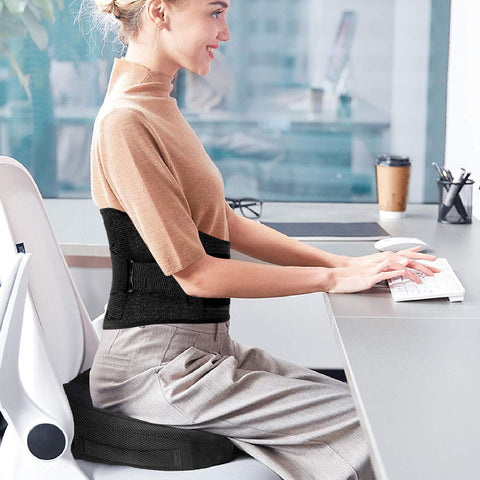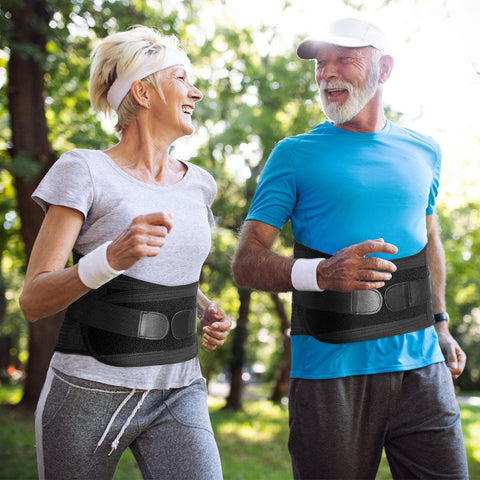Wie man eine Rückenklammer für Schmerzen im unteren Rücken trägt

Das Tragen einer Rückenstütze bei Schmerzen im unteren Rückenbereich ist zu einem beliebten Suchthema bei Google geworden.
Laut einem WHO-Bericht litten im Jahr 2020 etwa 619 Millionen Menschen unter Schmerzen im unteren Rückenbereich, und bis 2050 wird diese Zahl voraussichtlich auf 843 Millionen steigen. [1].
Menschen aller Altersgruppen können Rückenschmerzen entwickeln, und die meisten erleben sie mindestens einmal im Leben. Daher wird in diesem Artikel ausführlich erläutert, wie eine Rückenstütze bei Rückenschmerzen hilft und genau wie man bei Schmerzen im unteren Rücken eine Rückenstütze trägt.

Schmerzen im unteren Rücken verstehen: Ursachen und Arten
Wir müssen zunächst ein grundlegendes Verständnis dieses Symptoms entwickeln, um zu lernen, wie man bei Rückenschmerzen eine Rückenstütze trägt. Was verursacht also Rückenschmerzen? Sind Schmerzen im unteren Rücken bei allen gleich?
Anatomische Struktur des unteren Rückens
Der untere Rücken befindet sich direkt über Ihren Hüften. Fünf Knochen bilden zusammen mit zahlreichen Muskeln und Sehnen das „Rückgrat“ dieses Bereichs.
Der untere Rücken trägt das Hauptgewicht Ihres Oberkörpers und unterstützt verschiedene Bewegungen wie Drehen, Beugen und Heben, wodurch er anfällig für Verstauchungen und Verletzungen ist.
Ihr unterer Rücken weist eine natürliche Krümmung nach innen auf. Sie spielt eine entscheidende Rolle bei:
- Balancieren Sie das Gewicht Ihres Kopfes auf Ihrer Wirbelsäule
- Verteilen Sie das Gewicht des Oberkörpers
- Linderung von Verspannungen im unteren Rücken
Was sind die häufigsten Ursachen für Schmerzen im unteren Rücken?
Wenn wir nach dem Tragen einer Rückenstütze bei Rückenschmerzen suchen, fragen wir uns oft, wie wir die Stelle genau bestimmen und die Wirksamkeit der Rückenstütze maximieren können. In diesem Abschnitt untersuchen wir die häufigsten Ursachen für Rückenschmerzen und besprechen, wie diese Beschwerden mit einer Rückenstütze wirksam behandelt und verhindert werden können.
- Muskelzerrung und -verstauchung
Rückenschmerzen entstehen oft durch Zerrungen und Verstauchungen, die entstehen, wenn Muskeln, Sehnen oder Bänder über ihre normale Belastungsgrenze hinaus gedehnt werden. Dies kann durch falsche Hebetechniken, plötzliche Bewegungen wie Niesen oder Bücken oder übermäßige Anstrengung verursacht werden.
- Degenerative Erkrankungen
Unser Körper altert mit der Zeit auf natürliche Weise, was zu degenerativen Veränderungen der Wirbelsäule und der Muskeln führt. Osteoarthritis, Bandscheibenverschleiß und Spinalkanalstenose sind häufige Erkrankungen in diesem Zusammenhang.
- Verletzungen und Unfälle
Unfälle wie Stürze, Autounfälle oder Sportverletzungen können zu Wirbelsäulenfrakturen führen. Bestimmte Erkrankungen wie Spondylolyse oder Osteoporose erhöhen das Risiko von Wirbelsäulenfrakturen, da sie die Knochen schwächen.
- Schlechte Körperhaltung und Biomechanik
Schlechte Körperhaltungen wie Hohlkreuz, Rundrücken und Flachrücken können den unteren Rücken übermäßig belasten und so zu Schmerzen im unteren Rückenbereich führen. Sie können Schmerzen im unteren Rückenbereich auslösen, da Muskeln und Wirbelsäule ungleichmäßig belastet werden und mit der Zeit degenerieren.
Für ein umfassendes Verständnis der Körperhaltungen können Sie lesen 5 Haltungstypen: So verbessern Sie Ihre Haltung und beugen chronischen Verletzungen vor.
- Lebensstil und berufliche Faktoren
Langes Sitzen schwächt aufgrund mangelnder Bewegung die Muskeln, die die Wirbelsäule stützen, und kann das Risiko für Rückenschmerzen erhöhen. Auch bestimmte Berufe, die schweres Heben, langes Sitzen oder eine unbequeme Körperhaltung erfordern, können das Risiko für Rückenschmerzen erhöhen.
Entdecken Sie Tipps und Vorsichtsmaßnahmen für sicheres Gewichtheben.Bitte lesen So vermeiden Sie Rückenschmerzen beim Gewichtheben: 7 Techniken und Vorsichtsmaßnahmen, die Sie kennen sollten.

Welche Funktionen haben Rückenstützen bei Schmerzen im unteren Rücken?
Um Schmerzen im unteren Rückenbereich wirksam zu behandeln, ist es wichtig zu verstehen, wie eine Rückenorthese funktioniert. Hier sind vier wichtige Funktionen, die veranschaulichen, wie eine Rückenorthese Beschwerden lindert:
- Unterstützung: Rückenstützen bieten zusätzliche Unterstützung für die Muskeln, Sehnen und Bänder im Rücken und tragen dazu bei, die Belastung und den Druck auf diese Strukturen bei Aktivitäten wie Heben oder Bücken zu reduzieren.
- Ausrichtung: Rückenstützen können dabei helfen, die korrekte Ausrichtung der Wirbelsäule aufrechtzuerhalten, insbesondere bei Personen mit Erkrankungen wie Skoliose oder Spinalkanalstenose, indem sie die Wirbelsäule sanft in eine korrektere Position führen.
- Stabilisierung: Rückenstützen können zur Stabilisierung von Rücken und Taille beitragen und so Folgeverletzungen durch übermäßiges Verdrehen, Beugen oder Drehen vorbeugen. Dies gilt insbesondere für Menschen mit Rückenverletzungen, da sie übermäßige Bewegungen einschränken und weiteren Schäden vorbeugen.
- Kompression: Manche Rückenorthesen üben einen sanften Druck auf den Rücken aus, der Entzündungen reduzieren und Schmerzen lindern kann. Daher ist es bei der Wahl einer Rückenorthese zur Linderung von Rückenschmerzen wichtig, auf die richtige Kompression zu achten.
Wie wählen Sie die richtige Rückenstütze für Ihre Schmerzen im unteren Rückenbereich aus?
Bei der Auswahl der richtigen Rückenstütze sollten Sie vier Faktoren berücksichtigen.
- Schwere der Schmerzen
Bevor Sie sich für eine Rückenstütze entscheiden, ist es wichtig, die Art und Intensität Ihrer Schmerzen zu verstehen. Sind sie akut oder leicht? Bei leichten Rückenschmerzen reichen die weichen und leichten Rückenstützen aus.
Bei mittelschweren Rückenschmerzen kann eine stärker stützende Orthese mit einer Halterung oder einem verstärkten Gurt die bessere Wahl sein. Patienten mit starken Rückenschmerzen sollten sich vor der Entscheidung über eine mögliche Schmerzbehandlung professionell beraten lassen.
Sie sollten auch die Ursachen analysieren. Handelt es sich um eine Verletzung, eine bestimmte Erkrankung oder eine schlechte Körperhaltung? Es gibt Rückenorthesen zur Korrektur von Fehlhaltungen und zur Schmerzlinderung. Prüfen Sie vor dem Kauf die Optionen im Hinblick auf Ihre Ziele, da Orthesen unterschiedliche Ursachen behandeln und unterschiedlich wirken können.
- Aktivitätsanforderungen
Berücksichtigen Sie Ihre täglichen Aktivitäten und wählen Sie eine Rückenorthese, die Ihren spezifischen Bedürfnissen entspricht. Wenn Sie viele Aktivitäten ausführen müssen, entscheiden Sie sich für eine flexible und dennoch stützende Orthese, die Bewegungsfreiheit ermöglicht.
- Bei eher passiven Aktivitäten oder während Ruhephasen kann eine Orthese mit größerer Stabilität vorzuziehen sein.
- Für Sportler ist eine Rückenstütze mit schweißableitenden Materialien und einem flexiblen, stoßfesten Design, das speziell für sportliche Aktivitäten entwickelt wurde, von Vorteil. Sie sollten jedoch lernen, eine Rückenstütze richtig zu tragen, um Verletzungen zu vermeiden.
- Schwerarbeiter sollten bei der Auswahl einer Rückenstütze für schwere Hebearbeiten eine umfassende Rückenstütze in Betracht ziehen, um Schmerzen im unteren Rückenbereich zu lindern.
- Körpertyp und Größe
Wählen Sie die passende Größe für Ihren Körpertyp, um einen bequemen und sicheren Sitz der Rückenbandage zu gewährleisten. Messen Sie Ihren Taillen- oder Hüftumfang gemäß Herstellerempfehlung, um die richtige Größe zu bestimmen.
Berücksichtigen Sie außerdem verstellbare Funktionen wie Riemen oder Verschlüsse, um die Passform an Ihre individuelle Körperform anzupassen. Es ist auch wichtig zu lernen, wie man eine Rückenstütze bei Rückenschmerzen richtig trägt.
Beliebte Rückenorthesen gegen Schmerzen im unteren Rückenbereich von FIVALI
FIVALI, ein professioneller Anbieter von Fitnessbekleidung, bietet eine Vielzahl von Rückenorthesen an, die auf unterschiedliche Bedürfnisse zugeschnitten sind. Darüber hinaus bieten wir Ihnen einen Kundenservice, der Sie bei der Auswahl und beim Tragen einer Rückenorthese bei Rückenschmerzen unterstützt, um sicherzustellen, dass Sie die richtige Rückenorthese finden und richtig anwenden.
Die starre Rückenstütze verfügt über sieben verstärkte Stützstäbe, die sorgfältig konstruiert wurden, um Druck standzuhalten und zuverlässige Stabilität zu gewährleisten. Die austauschbaren Heiz- und Weichpolster sorgen für zusätzliche Wärme und Komfort zur Entspannung der Rückenmuskulatur.

Diese halbstarre Rückenstütze ist innen mit PVC verstärkt und sorgt so für Stabilität. Durch die Ausrichtung der Wirbelsäule und die Unterstützung des unteren Rückens trägt sie dazu bei, ein Rundrücken zu reduzieren und Fehlhaltungen vorzubeugen.

Für Personen, die Flexibilität benötigen, ist unsere flexible Rückenstütze die ideale Wahl.
Das feste und dennoch flexible Design unterstützt die Kompression und Stabilisierung des unteren Rückens. Fortschrittliche Belüftungstechnologie lässt die Haut atmen. Dank der personalisierten Funktion können Sie den Grad der Unterstützung und Kompression individuell anpassen.

Wie trägt man eine Rückenstütze bei Rückenschmerzen? Ein praktischer Leitfaden
Wissen Sie, wie Sie bei Schmerzen im unteren Rückenbereich beim Heben schwerer Lasten oder bei der Ausübung von Profisport eine Rückenstütze tragen?
Hier ist eine Schritt-für-Schritt-Anleitung zum Tragen einer Rückenorthese bei Schmerzen im unteren Rückenbereich:
- Wählen Sie eine Orthese, die speziell für Schmerzen im unteren Rückenbereich entwickelt wurde
- Verwenden Sie die offizielle Größentabelle als Referenz, um die beste Passform für Ihre Umstände zu finden.
- Positionieren Sie die Stütze um Ihren Rücken und achten Sie darauf, dass die Flügel für eine optimale Abdeckung an beiden Seiten Ihres Oberkörpers ausgerichtet sind.
- Passen Sie die Verschlüsse und Riemen an, um die Enge zu optimieren und einen festen Sitz zu gewährleisten.
Wie trägt man eine Rückenstütze bei Schmerzen im unteren Rückenbereich bequem und effektiv?
Wenn Sie in diesem Bereich Beschwerden wie Taubheitsgefühl, Kribbeln oder Schmerzen verspüren, ist die Orthese möglicherweise zu eng. Wenn Sie jedoch das Gefühl haben, dass sich die Orthese bei Aktivitäten bewegt oder nicht den nötigen Halt bietet, ist sie möglicherweise zu locker.
Um die Rückenstütze bequem zu tragen und gleichzeitig die Schmerzen zu lindern, müssen Sie auf Ihren Körper hören und die Tragedauer, -häufigkeit und -stärke dynamisch ändern.
Wie lange und wie oft sollten Sie tragen Rückenschienen bei Schmerzen im unteren Rücken?
Schmerzen im unteren Rückenbereich sind von Person zu Person unterschiedlich und die Bestimmung der optimalen Tragedauer und -häufigkeit ist entscheidend, um die besten Ergebnisse zu erzielen und gleichzeitig die Sicherheit zu gewährleisten.
Wenn Sie zum ersten Mal eine Rückenorthese tragen, empfiehlt es sich, diese zunächst nicht über längere Zeiträume zu tragen. Steigern Sie die Tragedauer stattdessen schrittweise, sobald Sie sich daran gewöhnt haben.
Wie kann man eine Rückenstütze durch Übungen und Therapie ergänzen?

Eine Rückenstütze sollte nur eine Notlösung zur Linderung von Rückenschmerzen sein. Letztendlich geht es darum, Muskeln und Knochen zu stärken, die Beweglichkeit zu verbessern und die Haltung zu korrigieren. Bewegung und Physiotherapie sind dabei entscheidend.
Zu den gängigen Übungen und Therapien bei Schmerzen im unteren Rückenbereich gehören:
- Übungen zur Stärkung der Körpermitte: Planks, Brücken und Bauchcurls
- Flexibilitätsübungen: Dehnung der Oberschenkelrückseite und der Wade sowie Katze-Kuh-Dehnungen
- Aerobic-Aktivitäten: Wandern und Radfahren
Abschluss
Rückenschmerzen haben erhebliche Auswirkungen auf unser Leben und unsere Arbeit. Glücklicherweise gibt es Rückenstützen, die helfen können. Wenn Sie auf der Suche nach einer geeigneten Rückenstütze sind, besuchen Sie FivaliWir bieten eine vielfältige Auswahl an hochwertigen Rückenstützen, die auf unterschiedliche Bedürfnisse und Situationen im Bereich der Rückenunterstützung zugeschnitten sind.
Entdecken Sie unsere Auswahl, um die perfekte Orthese zu finden, die Ihren spezifischen Anforderungen entspricht und Komfort und Wirksamkeit bei der Behandlung Ihrer Schmerzen im unteren Rückenbereich gewährleistet!
Referenz
[1] Weltgesundheitsorganisation/2023. Schmerzen im unteren Rücken. Verfügbar unter https://www.who.int/news-room/fact-sheets/detail/low-back-pain(Zugriff am 28. März 202)
-
Veröffentlicht in
Back pain causes, Brace













